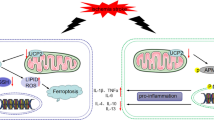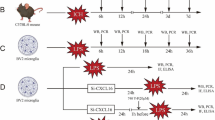Abstract
A transient ischemic attack (TIA) can cause reversible and delayed impairment of cognition, but the specific mechanisms are still unclear. Annexin a1 (ANXA1) is a phospholipid-binding protein. Here, we confirmed that cognition and hippocampal synapses were impaired in TIA-treated mice, and this could be rescued by multiple mild stimulations (MMS). TIA promoted the interaction of ANXA1 and CX3CR1, increased the membrane distribution of CX3CR1 in microglia, and thus enhanced the CX3CR1 and CX3CL1 interaction. These phenomena induced by TIA could be reversed by MMS. Meanwhile, the CX3CR1 membrane distribution and CX3CR1–CX3CL1 interaction were upregulated in primary cultured microglia overexpressing ANXA1, and the spine density was significantly reduced in co-cultured microglia overexpressing ANXA1 and neurons. Moreover, ANXA1 overexpression in microglia abolished the protection of MMS after TIA. Collectively, our study provides a potential strategy for treating the delayed synaptic injury caused by TIA.






Similar content being viewed by others
References
Easton JD, Saver JL, Albers GW, Alberts MJ, Chaturvedi S, Feldmann E, et al. Definition and evaluation of transient ischemic attack: A scientific statement for healthcare professionals from the American Heart Association/American Stroke Association Stroke Council; Council on Cardiovascular Surgery and Anesthesia; Council on Cardiovascular Radiology and Intervention; Council on Cardiovascular Nursing; and the Interdisciplinary Council on Peripheral Vascular Disease. The American Academy of Neurology affirms the value of this statement as an educational tool for neurologists. Stroke 2009, 40: 2276–2293.
Luengo-Fernandez R, Gray AM, Rothwell PM. Effect of urgent treatment for transient ischaemic attack and minor stroke on disability and hospital costs (EXPRESS study): A prospective population-based sequential comparison. Lancet Neurol 2009, 8: 235–243.
Adams RJ, Chimowitz MI, Alpert JS, Awad IA, Cerqueria MD, Fayad P. Coronary risk evaluation in patients with transient ischemic attack and ischemic stroke: A scientific statement for healthcare professionals from the Stroke Council and the Council on Clinical Cardiology of the American Heart Association/American Stroke Association. Circulation 2003, 108: 1278–1290.
Epsztein J, Ben-Ari Y, Represa A, Crépel V. Late-onset epileptogenesis and seizure genesis: Lessons from models of cerebral ischemia. Neuroscientist 2008, 14: 78–90.
Powers WJ, Rabinstein AA, Ackerson T, Adeoye OM, Bambakidis NC, Becker K, et al. Guidelines for the early management of patients with acute ischemic stroke: 2019 update to the 2018 guidelines for the early management of acute ischemic stroke: A guideline for healthcare professionals from the American heart association/American stroke association. Stroke 2019, 50: e344–e418.
Qin C, Zhou LQ, Ma XT, Hu ZW, Yang S, Chen M, et al. Dual functions of microglia in ischemic stroke. Neurosci Bull 2019, 35: 921–933.
Wright-** EC, Gutmann DH. Microglia as dynamic cellular mediators of brain function. Trends Mol Med 2019, 25: 967–979.
Wang YJ, Huang ZH. Microglia interact with neurons by forming somatic junctions. Neurosci Bull 2020, 36: 1085–1088.
Otto G. Synaptic nibbling. Nat Rev Neurosci 2018, 19: 322.
Ozdinler PH, Macklis JD. IGF-I specifically enhances axon outgrowth of corticospinal motor neurons. Nat Neurosci 2006, 9: 1371–1381.
Sellgren CM, Gracias J, Watmuff B, Biag JD, Thanos JM, Whittredge PB, et al. Increased synapse elimination by microglia in schizophrenia patient-derived models of synaptic pruning. Nat Neurosci 2019, 22: 374–385.
Brown GC, Neher JJ. Microglial phagocytosis of live neurons. Nat Rev Neurosci 2014, 15: 209–216.
Sekar A, Bialas AR, de Rivera H, Davis A, Hammond TR, Kamitaki N, et al. Schizophrenia risk from complex variation of complement component 4. Nature 2016, 530: 177–183.
Paolicelli RC, Bolasco G, Pagani F, Maggi L, Scianni M, Panzanelli P, et al. Synaptic pruning by microglia is necessary for normal brain development. Science 2011, 333: 1456–1458.
Bolós M, Perea JR, Terreros-Roncal J, Pallas-Bazarra N, Jurado-Arjona J, Ávila J, et al. Absence of microglial CX3CR1 impairs the synaptic integration of adult-born hippocampal granule neurons. Brain Behav Immun 2018, 68: 76–89.
Ransohoff RM. Chemokines and chemokine receptors: Standing at the crossroads of immunobiology and neurobiology. Immunity 2009, 31: 711–721.
Harrison JK, Jiang Y, Chen S, **a Y, Maciejewski D, McNamara RK, et al. Role for neuronally derived fractalkine in mediating interactions between neurons and CX3CR1-expressing microglia. Proc Natl Acad Sci U S A 1998, 95: 10896–10901.
Moss SE, Morgan RO. The annexins. Genome Biol 2004, 5: 219.
Lim LH, Solito E, Russo-Marie F, Flower RJ, Perretti M. Promoting detachment of neutrophils adherent to murine postcapillary venules to control inflammation: Effect of lipocortin 1. Proc Natl Acad Sci U S A 1998, 95: 14535–14539.
Tabe Y, ** L, Contractor R, Gold D, Ruvolo P, Radke S, et al. Novel role of HDAC inhibitors in AML1/ETO AML cells: Activation of apoptosis and phagocytosis through induction of annexin A1. Cell Death Differ 2007, 14: 1443–1456.
Flower RJ. Lipocortin and the mechanism of action of the glucocorticoids. Br J Pharmacol 1988, 94: 987–1015.
Gerke V, Creutz CE, Moss SE. Annexins: linking Ca2+ signalling to membrane dynamics. Nat Rev Mol Cell Biol 2005, 6: 449–461.
Kwon JH, Lee JH, Kim KS, Chung YW, Kim IY. Regulation of cytosolic phospholipase A2 phosphorylation by proteolytic cleavage of annexin A1 in activated mast cells. J Immunol 2012, 188: 5665–5673.
Jiwa NS, Garrard P, Hainsworth AH. Experimental models of vascular dementia and vascular cognitive impairment: A systematic review. J Neurochem 2010, 115: 814–828.
Kirino T, Tamura A, Sano K. Delayed neuronal death in the rat Hippocampus following transient forebrain ischemia. Acta Neuropathol 1984, 64: 139–147.
Tye KM, Mirzabekov JJ, Warden MR, Ferenczi EA, Tsai HC, Finkelstein J, et al. Dopamine neurons modulate neural encoding and expression of depression-related behaviour. Nature 2013, 493: 537–541.
Vorhees CV, Williams MT. Morris water maze: Procedures for assessing spatial and related forms of learning and memory. Nat Protoc 2006, 1: 848–858.
Li X, **a Q, Mao M, Zhou HJ, Zheng L, Wang Y, et al. Annexin-A1 SUMOylation regulates microglial polarization after cerebral ischemia by modulating IKKα stability via selective autophagy. Sci Adv 2021, 7: eabc5539.
Bian WJ, Miao WY, He SJ, Qiu ZL, Yu X. Coordinated spine pruning and maturation mediated by inter-spine competition for cadherin/catenin complexes. Cell 2015, 162: 808–822.
Sholl DA. Dendritic organization in the neurons of the visual and motor cortices of the cat. J Anat 1953, 87: 387–406.
Wang YL, Zhao XQ, Jiang Y, Li H, Wang LM, Johnston SC, et al. Prevalence, knowledge, and treatment of transient ischemic attacks in China. Neurology 2015, 84: 2354–2361.
Jiang B, Sun HX, Ru XJ, Sun DL, Chen ZH, Liu HM, et al. Prevalence, incidence, prognosis, early stroke risk, and stroke-related prognostic factors of definite or probable transient ischemic attacks in China, 2013. Front Neurol 2017, 8: 309.
Hackam DG, Spence JD. Combining multiple approaches for the secondary prevention of vascular events after stroke: A quantitative modeling study. Stroke 2007, 38: 1881–1885.
Wahl D, Cogger VC, Solon-Biet SM, Waern RVR, Gokarn R, Pulpitel T, et al. Nutritional strategies to optimise cognitive function in the aging brain. Ageing Res Rev 2016, 31: 80–92.
Bekinschtein P, Oomen CA, Saksida LM, Bussey TJ. Effects of environmental enrichment and voluntary exercise on neurogenesis, learning and memory, and pattern separation: BDNF as a critical variable? Semin Cell Dev Biol 2011, 22: 536–542.
Lodha N, Harrell J, Eisenschenk S, Christou EA. Motor impairments in transient ischemic attack increase the odds of a subsequent stroke: A meta-analysis. Front Neurol 2017, 8: 243.
Weinhard L, di Bartolomei G, Bolasco G, Machado P, Schieber NL, Neniskyte U, et al. Microglia remodel synapses by presynaptic trogocytosis and spine head filopodia induction. Nat Commun 2018, 9: 1228.
Zhao BM, Wang J, Liu L, Li X, Liu SX, **a Q, et al. Annexin A1 translocates to nucleus and promotes the expression of pro-inflammatory cytokines in a PKC-dependent manner after OGD/R. Sci Rep 2016, 6: 27028.
Liu L, An DD, Xu JY, Shao B, Li X, Shi J. Ac2-26 induces IKKβ degradation through chaperone-mediated autophagy via HSPB1 in NCM-treated microglia. Front Mol Neurosci 2018, 11: 76.
Luo ZZ, Gao Y, Sun N, Zhao Y, Wang J, Tian B, et al. Enhancing the interaction between annexin-1 and formyl peptide receptors regulates microglial activation to protect neurons from ischemia-like injury. J Neuroimmunol 2014, 276: 24–36.
Acknowledgements
This work was supported by the National Natural Science Foundation of China (31771126).
Author information
Authors and Affiliations
Corresponding authors
Ethics declarations
Conflict of interest
All authors declare that they have no interest conflict.
Supplementary Information
Below is the link to the electronic supplementary material.
Rights and permissions
About this article
Cite this article
Zheng, L., Wang, Y., Shao, B. et al. Multiple Mild Stimulations Reduce Membrane Distribution of CX3CR1 Promoted by Annexin a1 in Microglia to Attenuate Excessive Dendritic Spine Pruning and Cognitive Deficits Caused by a Transient Ischemic Attack in Mice. Neurosci. Bull. 38, 753–768 (2022). https://doi.org/10.1007/s12264-022-00847-4
Received:
Accepted:
Published:
Issue Date:
DOI: https://doi.org/10.1007/s12264-022-00847-4




